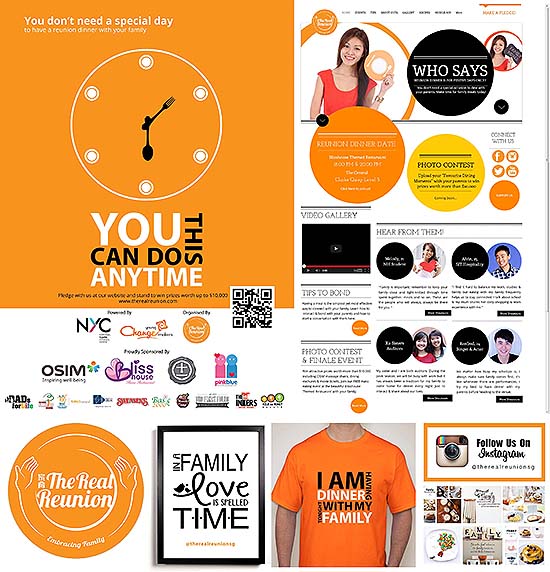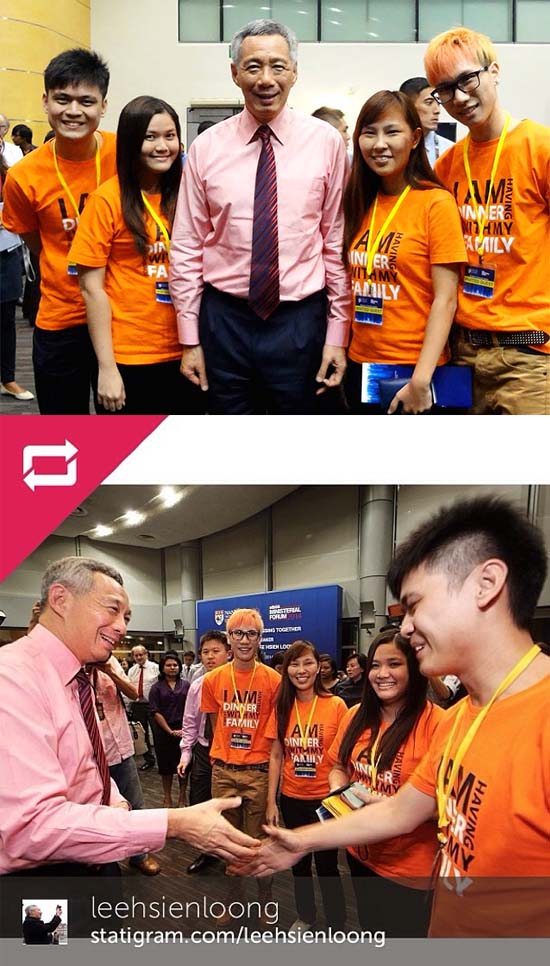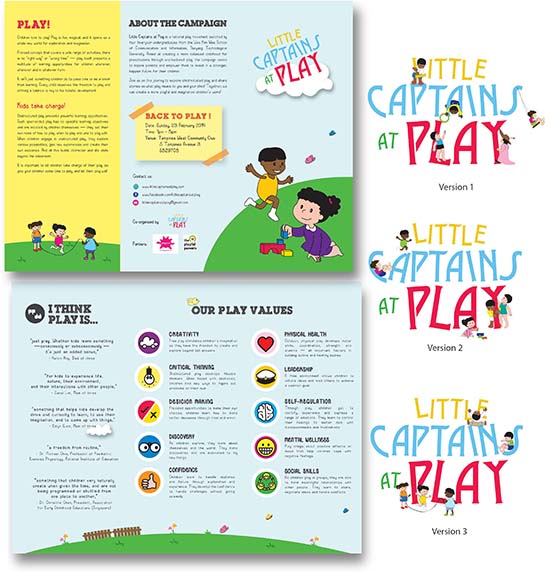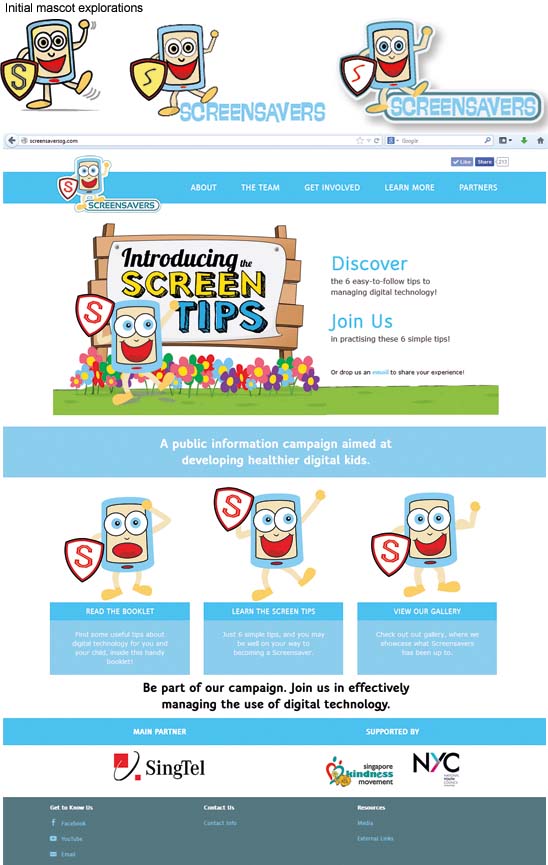| |
The Real Reunion: An Integrated Campaign to Strengthen Family Bonds Through Meals

Reunion Dinner is a time to reconnect, preserve and reinforce kinship ties. It also signify a promise, tolerant and love for one another within the family. Desmond Lim Hiok Hwee, Toh Yew Zhen, Chen Zhihui and Tan Nian Shun, through a communication campaign, are aiming to reconnect youths with their parents, encourage greater communication and interaction between youths and their parents to develop a more satisfying and healthy relationship. Although many Singaporeans know the importance of family relationships; many lack the motivation to foster strong ties with their family. With busy work and school schedules, the difficulty of having family meals together has increased. Singaporeans are currently looking for the right balance that would allow them to have more time with their families (Our Singapore Conversation Survey, 2013). Youths today have countless of distractions, more activities outside home and a continuous engagement with modern technology. These are factors that contributes to the lack of initiation and commitment to family meals. Recognizing food as an important aspect for most Singaporeans, they aim to educate and persuade youths (18 - 25) to bond with their parents using food as their core strategy by highlighting the importance of having family meals together.
Based on the AIDA (Attention-Interest-Desire-Action) model as a framework, the campaign is broken down into four key phases: i) employing the use of popular social media tools; ii) website and an interactive mobile application to garner attention and interest; iii) leveraging on multiple school outreach, an outdoor roadshow; and iv)a finale mass family reunion dinner event to create desire and action. Formative evaluation, quantitative survey and qualitative focus group interview were done prior to the launch of the campaign where they collected information to identify the scope of the problem, formulate key messages and campaign strategies. This was then split into four steps: Target audience identification, Target behavior specification, Identification of steps to take between message exposure and behavior change and Selection of channels to disseminate campaign message (Atkin & Freimuth, 2001). The data was collected during early October 2013, convenience sampling was carried out via online and physical methods but measures were taken to ensure a mix of demographics for a fair representation of our target audience. The survey comprises of multiple choice questions, 5-point Likert scales and semantic differential scale. The scale consisted of bipolar adjectives reflecting extremely opposite words used to describe family meals such as meaningless and meaningful. All together, a total of 303 surveys were completed and consisted of 59% students and 41% young working adult.
For the color scheme, we decided to play with the color orange as it signifies warmth and energy. As the main target audience in our campaign are youths, they want a vibrant yet heart warming feeling of families within the logo. Minimalistic vector illustrations were used in all collateral to convey the fun and youthful spirit of our campaign. Additionally, this visual style of utilizing clean and simple lines was chosen to add a professional and contemporary feel, in hopes of appealing to the youthful target audience. Most of the graphics were also iconic in nature to communicate clearly and ease understanding of various abstract concepts.They summarized their findings in a graphically interesting YouTube video. You'll be informed that eating together with your family has various benefits...
Website: www.therealreunion.com
Facebook: www.facebook.com/therealreunionsg
Instagram: www.instagram.com/therealreunionsg
Twitter: twitter.com/therealreunion
Youtube: www.youtube.com/user/therealreunionsg

The Real Reunion: An Integrated Campaign to Strengthen Family Bonds Through Meals

Recently, during the Nanyang Technological University Ministerial Forum 2014 titled "Singapore: Progressing Together," on January 28, 2014, the Prime Minister of Singapore, Mr Lee Hsien Long mentioned the Real Reunion, a final year project from 4 students I supervised in his address. The Real Reunion team wrote to PM Lee about their efforts to bond families through meals and they were delighted be invited as VIP guests to the forum. The PM also wrote the following "I am happy that 'The Real Reunion' team at NTU are doing something to encourage families to bond over meals. A 'Real Reunion' indeed transcends race, culture and tradition. In this International Year of the Family, let us cherish not just festive holidays but also everyday moments with our family, and our extended family too."
For more: http://www.therealreunion.com/#!gallery/co5h

Little Captains At Play: A Campaign for Unstructured Play towards a more Balanced Childhood among Preschoolers in Singapore

A co-supervision with Mr Stephen Robertson of Edelman, Madeline Soh Hui Ting, Law Kwee Fang, Claire Yeoh Su-en and Tan Xiang Wei want to encourage parents to allow their children the freedom to create their own play. When adults become too controlling over the activity, children are forced to conform to set rules and lose the opportunity to play and explore on their own (Ginsburg, 2007). Too early intervention in children's play activities also undermine children's ability to learn from mistakes, negotiate and find creative solutions to problems (Santer, Griffiths, & Goodall, 2007). They aim to inspire parents to provide their children with more opportunities for unstructured play. The vision of the campaign is to create a balanced childhood for preschoolers through unstructured play. For the purpose of their campaign, "Structured Play" refers to play with set rules and clearly defined learning objectives. Adults guide children in these activities and determine the materials for play while "Unstructured Play" is open-ended and has no specific learning objectives. These activities are initiated by children themselves, and they set their own rules of how to play, when to play and who to play with. Unstructured play can also be used simultaneously with the terms, free play, spontaneous play or child-initiated play.
Some key advantages to unstructured play are listed as follows:
- Creativity
- Critical thinking & Problem-solving
- Decision Making
- Discovery
- Confidence
- Physical Health
- Leadership
- Self-regulation
- Mental Wellness
- Social Skills
Building on the key findings obtained from the in-depth interviews, the quantitative survey was conducted to gather data on children's present playtime as well as parents' perceptions towards structured and unstructured play in children's learning and development. The survey comprised a self-administered questionnaire completed by parents with preschoolers aged 3 to 6 years old. A total of 101 parents who belong to the middle and upper middle income groups were surveyed between mid-September 2013 and mid-October 2013. Due to limited resources and time, the survey was conducted through the purposive sampling method. Pen-and-paper survey questionnaires were administered on the street across Singapore in the North, South, East and West regions. The survey was also distributed to two childcare centers in the East and West. Additionally, the survey was administered through an online web survey to maximize number of respondents.
A mere 32% of parents who were surveyed believed that unstructured play is most important for their children's learning and development. Data revealed that structured activities such as teaching children to read and attending interest class are more essential than unstructured activities such as playing outdoors freely and playing with open-ended toys. This could be due to parents wanting their children to gain knowledge as 78% think it is important for their children to learn as much as possible during the early years, and learning value was ranked as most important consideration in deciding activities for children. Furthermore, 80% of the parents believed that play is best when their children learn something out of it. While 90% of the parents think it is important for their children to acquire soft skills such as creativity, problem-solving and social skills, only 56% reported engaging their children in unstructured play i.e. playing with open-ended toys and outdoors freely, drawing and painting freely, and role-playing as their top three activities.
Website: www.littlecaptainsatplay.com
Facebook: https://www.facebook.com/littlecaptainsatplay.sg?fref=ts
Instagram: www.instagram.com/therealreunionsg
Email: littlecaptainsatplay@gmail.com

Screensavers: A Public Information Campaign on Building Healthier Digital Kids

Titled Screensavers: A Public Information Campaign on Building Healthier Digital Kids", this co-supervision with Dr Shin Wonsun for students Charis Pek Kai Le, Marlene Tan Yiting, and Ng Pin Li has a few purposes: to explore the current digital technology landscape in Singapore, understand parents' perspectives on digital technology mediation and identify tactics and strategies in the execution of a campaign targeting the promoting of healthy digital technology use amongst parents and their children aged 6 to 12.
In evaluating these campaigns, the team noticed that the focus of the campaigns have expanded beyond just cyber wellness and they target mainly the children through broadcast media, exhibition and youth conferences. However, we have also learned from various campaigns and events that to reach the children and their parents more effectively, we can collaborate with the schools directly. While the team strongly believes in having parents alongside their children in their learning journey, this has helped us to strategize our campaign engagement activities to involve both parents and the children. To ensure comprehensive primary research, we identified a combination of three types of qualitative and quantitative research, namely in-depth interviews, surveys and focus groups.A total of seven schools took part in the survey, with 972 survey questionnaires distributed. 554 valid responses were received, with a response rate of 57%.
Exploring current mediation styles, more common practices by parents include respondents guiding their children by enquiringly over their activities (82%), limiting their children's technology use (78%) and talking to their children about what they should or should not share online (69%). On the other hand, respondents assert less control through sitting with their children when they use technology (25%), checking the device to determine past activity (28%) and disallowing the use of social networking tools (30%). The study also found that according to their parents, 97% of the children aged 6-12 used digital devices (either smartphones, tablets or computers) at home. 82%, 64% and 68% of the children used the computer, tablet and smartphone, respectively. The main function of digital devices amongst them is primarily for educational purposes (87%) and for leisure (85%). Respondents opined that friends influence their children's digital technology use the most, with 59% of respondents seeing them as very or extremely influential. Parents come in a close second, with 53% of respondents seeing them as very or extremely influential.
In addition to having SingTel, the Singapore Kindness Movement and the National Youth Council as sponsors, the Screensavers team was interviewed on Singapore's Channel NewsAsia's in January 2014. Watch the YouTube for more information with Charis Pek (left) and Marlene Tan (right) explaining about their campaign.
Screensaver URL: http://screensaverssg.com and www.facebook.com/screensaverssg

|
|
YEOH AS EDUCATOR
- MY STUDENTS' CREATIONS
- MY WRITINGS
Select below to view my students' awards as well as their creations from Nanyang Technological University, Texas Tech University, and Southern Arkansas University.
|